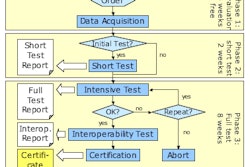Consultant Tom Aug, who leads strategic planning retreats for healthcare groups, often comes up against something he calls "the Kumbaya effect," after a campfire song that is considered a tribute to unity and harmony. In a straightforward way, Aug -- president of Cincinnati-based Development Partners -- dispatches with people's assumption that a strategic planning session is a touchy-feely hippie-era waste of time.
"People ask 'What are we going to do at (this retreat), sit around and sing 'Kumbaya'? So I usually start every retreat with everyone holding hands and we sing 'Kumbaya.' We get that out of the way," explained Aug, speaking last week at a Radiology Business Management Association (RBMA) meeting in San Francisco. "Strategic planning is too 'soft' for some people. But I would purport that strategic planning is anything but soft. It's looking at hard data, looking at market trends, and looking at the future of your industry. I don't think there's anything soft about that, but that's the image."
It falls to radiology business administrators to prove to their group that strategic planning is a structured opportunity for members of a practice to talk about their future, Aug said. He offered some basic guidelines on how to get the ball rolling on strategic planning.
Getting people together
Who should be involved in strategic planning? First, Aug pointed out that it would be a waste of time for a business administrator to try to convince physicians to buy in to a strategic plan, not to mention the time and effort required to produce it. So before bringing the plan to the whole group, Aug suggested that an administrator partner up with a like-minded physician ally.
"I think you need to engage the more business-savvy MDs in your group. I don't mean the guy who manages the pension plan. Not the financial-savvy guys, but the people who understand business. Maybe you've got an MBA in your group, so you've got to involve them to help them sell it to others in the group. I don't know any administrator that can sell (strategic planning) to physicians," said Aug, who was a radiology business manager for 10 years.
Aug suggested that the strategic planning committee should consist of between three and five people, including the appropriate physicians, the CEO or president of the group, and the administrator. Another person that a practice has the option of an involving is an outside facilitator to run the strategic planning sessions.
Aug pointed out some of the pros of having a nonpartisan facilitator:
- Allows members of the planning committee to participate without having to run the show.
- Gives structure to the process so that one person cannot dominate the meeting.
- Can encourage participants to tackle difficult issues.
- Enforces the ground rules for the meeting.
- Keeps the agenda moving forward.
Aug also acknowledged the drawbacks of hiring an outside facilitator, such as the cost and the time required for that individual to learn about the market and the group. In addition, facilitators will not stay on to monitor the group to see if the strategic planning is being implemented.
But if an outside facilitator is chosen, part of his or her job will be to interview all the retreat participants beforehand. Often, people are willing to share their grievances with someone who is not directly associated with the practice, Aug said. By having this information, the facilitator would be in a better position to prevent the retreat from dissolving into personal attacks and arguments.
Planning for the future
Most everyone, including physicians, are driven by self-interest so the best way to get them to take a long-term outlook is to offer compelling data on what will impact the future, such as marketplace competition (nighthawk services, teleradiology) or projected reimbursement cuts.
Also, retreat participants should be aware that a strategic plan must focus on the long-term (next 12 months). It can include decisions about changes in the direction of the practice or new services and locations. Aug stressed that, unlike operational or near-term planning, the outcome of a strategy cannot be predetermined.
"You don't know how this strategic planning is going to turn out because it's going to be built from inside the group. There is a certain amount of ambiguity and chaos in planning. It's not like reading a film. It's not that exact and that's hard for some people," he said.
Operational planning focuses on more immediate issues, such as how to implement an emergency medical records (EMR) system or design care protocols.
Picking the place, setting the ground rules
Aug suggested that the retreat be held over a weekend, for a minimum of a day and a half, in a location requiring no more than a two-hour drive. All partners in the practice should attend. Physicians should arrange for coverage before the retreat to minimize interruptions.
"I think there is something really important about getting away even if it's just a driving for an hour," Aug said. "Psychologically, you are no longer at work -- you are somewhere else."
As for ground rules, these should include the following:
- Speak honestly.
- Participate fully.
- Do not interrupt when others are speaking.
- Support the decisions made.
Finally, "avoid group think," Aug advised. "That simply says that we don't all go along because we think everybody else is going along."
The agenda and the execution
A strategic planning session agenda can either be open-ended or very specific -- that is dealing with issues that are so obvious or consistent that they must be addressed at the meeting, Aug said. An open-ended agenda could focus more on the general trends in the external landscape of a practice, such as referral patterns or competitive forces.
Either way, by the end of the planning session, participants must see that an actual plan has been laid out and documented. "You've got to come up with something at the end or people will leave frustrated," Aug said.
The agenda should also do the following:
- Revisit the practice's mission and vision, possibly even revising it.
- Select initiatives and the criteria of following through on them (consistency with mission, resources, buy-in).
- Write a plan that includes agreed-upon initiatives, obstacles, tasks, and timeline.
In addition, there is a written presentation that Aug called a "situation audit," which will list the key takeaways that are slated for discussion at the retreat. This document should also identify a practice's primary strengths, weaknesses, opportunity, and threats.
"The situation audit is presented by the facilitator or the business administrator," Aug explained. "You've got this report and it has to be boiled down into small bits. It can't be 30 pages. If it's distributed to people ahead of time, that's better but it needs to be condensed more at the retreat."
Finally, Aug stressed that in addition to writing up the plan at the retreat, a system needs to be in place to execute the plan. "Part of (execution) is distributive accountability," he said. "The worst plan you can have has one person's name in the 'person responsible' column. Usually, it's the administrator. Part of the process is to get the people in strategic planning group to take ownership."
The planners will also have to figure out a way to communicate what happened at the retreat to those who did not attend, particularly the employees.
"It's a physician-driven process," Aug concluded. "It's got to come from the inside out. The plan is about 'we' and not 'me.' It's all about execution. Planning has to be part of your DNA. Once the retreat is over, people have to say: 'When are we revisiting this? How are we going to hold ourselves accountable? When will the next retreat be?' Then you know that it's been successful."
By Shalmali Pal
AuntMinnie.com staff writer
February 13, 2007
Related Reading
Workflow, communication tools offer new hope for productivity, August 1, 2006
Strategic planning considerations and the Deficit Reduction Act of 2005, June 27, 2006
Copyright © 2007 AuntMinnie.com



















